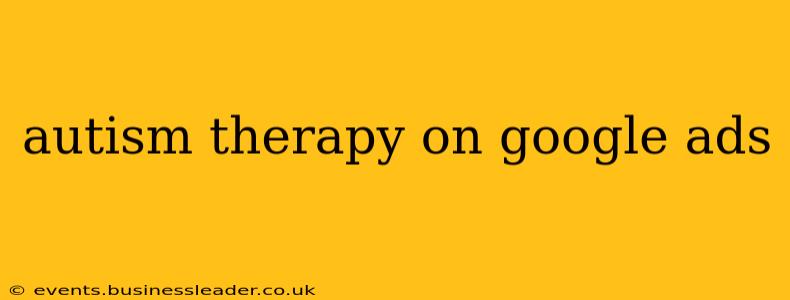Navigating the Complex World of Autism Therapy Ads on Google
Advertising autism therapy services on Google Ads requires a delicate balance between reaching families in need and adhering to Google's strict advertising policies. The platform prohibits misleading claims and demands transparency and ethical considerations given the sensitive nature of the services offered. This guide explores the intricacies of running successful and responsible autism therapy ads on Google.
What are the Google Ads policies regarding autism therapy?
Google Ads has specific policies regarding the advertising of healthcare services, including autism therapy. These policies aim to protect consumers from misleading or unsubstantiated claims. Key restrictions often include:
- Prohibition of unsubstantiated claims: Ads cannot make claims about curing autism or guaranteeing specific outcomes. Autism is a lifelong neurological condition, and any advertising must reflect this reality. Focus on providing support, improving skills, and enhancing quality of life.
- Clear and accurate description of services: Ads must clearly specify the types of therapy offered (e.g., Applied Behavior Analysis (ABA), speech therapy, occupational therapy). Avoid vague or ambiguous language.
- Licensing and credentials: Advertisers must be properly licensed and qualified to provide the advertised services. This often requires displaying relevant certifications and qualifications within the ad copy or landing page.
- Compliance with HIPAA: All advertising and subsequent interactions must comply with the Health Insurance Portability and Accountability Act (HIPAA) to protect patient privacy.
- Targeting restrictions: Google may place restrictions on targeting certain demographics or keywords to avoid discriminatory practices.
What are some effective strategies for autism therapy ads?
Creating effective Google Ads campaigns for autism therapy requires a nuanced approach that prioritizes ethical considerations alongside marketing goals:
- Keyword Research: Focus on long-tail keywords that reflect the specific needs of parents and caregivers. Examples include "ABA therapy for nonverbal autism near me," "speech therapy for autistic toddlers," or "occupational therapy for sensory processing disorder." Avoid overly broad terms.
- Compelling Ad Copy: Craft ad copy that is empathetic, informative, and reassuring. Highlight the benefits of your services, emphasizing improvements in communication, social skills, or daily living abilities. Avoid medical jargon.
- Targeted Landing Pages: Create dedicated landing pages for each ad group that provide detailed information about the specific therapy offered, the therapist's qualifications, and client testimonials.
- Negative Keywords: Utilize negative keywords to prevent your ads from showing for irrelevant searches, improving your Quality Score and reducing wasted ad spend.
- A/B Testing: Continuously test different ad copy variations, headlines, and landing pages to optimize your campaign performance and discover what resonates best with your target audience.
- Location Targeting: Utilize location targeting to reach families within your service area. Consider hyperlocal targeting to maximize reach within specific communities.
What types of autism therapy are most commonly advertised?
Several types of autism therapy are frequently advertised online:
- Applied Behavior Analysis (ABA): This evidence-based therapy focuses on modifying behaviors through positive reinforcement and other techniques.
- Speech Therapy: Addresses communication challenges, improving verbal and nonverbal communication skills.
- Occupational Therapy: Helps individuals develop daily living skills and addresses sensory processing issues.
How can I ensure my ads comply with Google's policies?
To ensure compliance, thoroughly review Google's advertising policies related to healthcare services and autism therapy. Before launching any campaign, carefully review your ad copy and landing pages to ensure they meet all requirements. Consider consulting with a legal professional specializing in healthcare advertising to ensure compliance and minimize risk.
How do I measure the success of my Google Ads campaign?
Tracking the success of your autism therapy Google Ads campaign requires monitoring key metrics, including:
- Click-Through Rate (CTR): The percentage of users who click on your ad after seeing it.
- Conversion Rate: The percentage of clicks that result in a desired action, such as a phone call, form submission, or appointment scheduling.
- Cost Per Acquisition (CPA): The cost of acquiring a new client.
- Return on Ad Spend (ROAS): The return on investment from your ad spend.
Regularly analyze these metrics to identify areas for improvement and optimize your campaign for better results.
By carefully considering these factors and adhering to Google's policies, you can create effective and ethical Google Ads campaigns that connect families with the autism therapy services they need. Remember that ethical considerations and transparency are paramount in this sensitive area.
